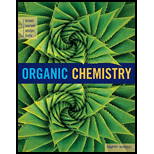
Concept explainers
(a)
Interpretation:
The product formed by treating acetophenone with the given reagent has to be drawn.
(b)
Interpretation:
The product formed by treating acetophenone with the given reagent has to be drawn.
(c)
Interpretation:
The product formed by treating acetophenone with the given reagent has to be drawn.
(d)
Interpretation:
The product formed by treating acetophenone with the given reagent has to be drawn.
(e)
Interpretation:
The product formed by treating acetophenone with the given reagent has to be drawn.
(f)
Interpretation:
The product formed by treating acetophenone with the given reagent has to be drawn.
(g)
Interpretation:
The product formed by treating acetophenone with the given reagent has to be drawn.
(h)
Interpretation:
The product formed by treating acetophenone with the given reagent has to be drawn.
(i)
Interpretation:
The product formed by treating acetophenone with the given reagent has to be drawn.
(j)
Interpretation:
The product formed by treating acetophenone with the given reagent has to be drawn.
(k)
Interpretation:
The product formed by treating acetophenone with the given reagent has to be drawn.
Want to see the full answer?
Check out a sample textbook solution
Chapter 16 Solutions
Organic Chemistry
- Synthesize 2-Hydroxy-2-phenylacetonitrile from phenylmethanol using the necessary organic or inorganic reagents. Draw the structures of the compounds.arrow_forwardSynthesize N-Methylcyclohexylamine from cyclohexanol using the necessary organic or inorganic reagents. Draw the structures of the compounds.arrow_forwardSynthesize N-Methylcyclohexylamine from cyclohexanol using the necessary organic or inorganic reagents. Draw the structures of the compounds.arrow_forward
- If possible, please provide the formula of the compound 3,3-dimethylbut-2-enal.arrow_forwardSynthesize 1,4-dibromobenzene from acetanilide (N-phenylacetamide) using the necessary organic or inorganic reagents. Draw the structures of the compounds.arrow_forwardIndicate the products obtained by mixing (3-oxo-3-phenylpropyl)triphenylphosphonium bromide with sodium hydride.arrow_forward
- We mix N-ethyl-2-hexanamine with excess methyl iodide and followed by heating with aqueous Ag2O. Indicate the major products obtained.arrow_forwardIndicate the products obtained by mixing acetophenone with iodine and NaOH.arrow_forwardIndicate the products obtained by mixing 2-Propanone and ethyllithium and performing a subsequent acid hydrolysis.arrow_forward
- Indicate the products obtained if (E)-2-butenal and 3-oxo-butanenitrile are mixed with sodium ethoxide in ethanol.arrow_forwardQuestion 3 (4 points), Draw a full arrow-pushing mechanism for the following reaction Please draw all structures clearly. Note that this intramolecular cyclization is analogous to the mechanism for halohydrin formation. COH Br + HBr Brarrow_forwardIndicate the products obtained if 2,2-dimethylpropanal and acetaldehyde are mixed with sodium ethoxide in ethanol.arrow_forward
 Organic ChemistryChemistryISBN:9781305580350Author:William H. Brown, Brent L. Iverson, Eric Anslyn, Christopher S. FootePublisher:Cengage Learning
Organic ChemistryChemistryISBN:9781305580350Author:William H. Brown, Brent L. Iverson, Eric Anslyn, Christopher S. FootePublisher:Cengage Learning
